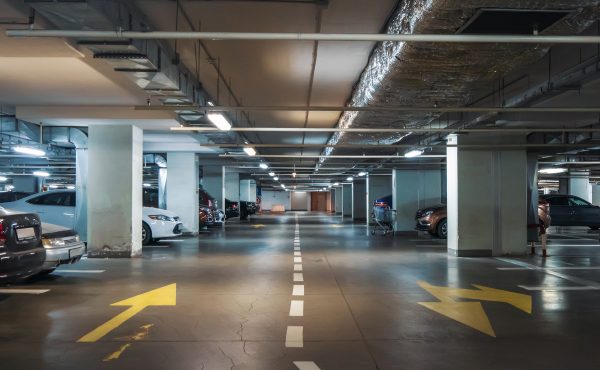I live in a concrete box downtown. I work as a young professional at a prominent downtown non-profit. In the months when I can actually feel my face, I bike five kilometres to work every day. And I’m damn proud of the lifestyle. Well, otherwise than the utter lack of community at CityPlace, the setting for my concrete box.
I have lived in CityPlace (I can hear the mounting exasperation already) for almost two years now. I enjoy the downtown vibe, the access to streetcars, the waterfront, shitty bike lanes and a dog park for Hank—my stupidly adorable Welsh Terrier—all within a short jaunt in a pair of Ugg boots away. I love our concrete box as well, as my partner and I were the first inhabitants in the space, and thus decorated as we saw fit.
What I can’t seem to get past, daily, is the lack of community at CityPlace. Put simply, it’s a hub for a swath of the city’s young people (vast majority are under 35) with a lot of spare change (my underground garage is rife with Mercedes, BMWs and the occasional Aston Martin), that acts like a post-university residence. A residency, however, where no one, although all similar in age and yuppiedom, tends to interact with one another. I know we live in Toronto and all, but guys, it’s getting old.
Since CityPlace has now inaccurately been called a future ghetto, which, based on its proximity to the CN Tower, Thompson Hotel, the waterfront, King St., Bay St. and so on, this notion will never come to fruition. CityPlace may decay, sure, especially with a lot of my fellow condo dwellers renting their condos and not up-keeping them as they would if they had purchased them. But ghetto is a misnomer here.
The real issue, oddly, is the aloofness of community. The number of times that someone has hastily tried to hit the “close door” button in the elevator as I approach is almost humourous. (I can see you, you know, rabid button hitters. I know what you’re up to.) No one smiles in the halls, and if you do, you tend to give the wrong impression, I guess. When walking Hank with his fancy new wool sweater (read: yuppie) in the dog park, a place known to attract the odd visitor, I thought I couldn’t go wrong. Erroneous I was, again. Sure, there are a shitload of dogs in the area, yet it is typically an interaction between the two dogs, rarely the owners. It’s often pleasurable to try and spark a light discussion with a pet owner only to get a disapproving look followed by their quickened escape—much to Hank’s chagrin. (I typically have to apologize to Hank for losing him a new friend. He makes me promise not to open my mouth the next time we meet a potential new friend.)
So, fellow CityPlace dwellers, where’s the love? I know that we don’t have a solid coffee shop—outside of Spot Coffee, which is meh at best—to call ourselves a nice little community with a local coffee shop to hang. (We do have a wickedly overpriced Sobey’s though.) But since we’ve all been around this neighbourhood for a few years now, since we’re all the same age, and since we all have dogs, can’t we, you know, at least say hi in the hallways? Just like in university. We can even be prepubescently awkward about it. Whatever works. Let’s just lighten up a bit, shall we?
Oh, and could you hold the elevator door for me next time? Hank is in a hurry too. He has friends to make.
Photo by Sam Xu.





22 comments
This is spot on. I lived in CityPlace for a year and it was like pulling teeth.
Sometimes I think it has a lot to do with the built form.
In Hong Kong there are any number of anonymous towers but because of the incredible humidity there and the lack of AC in older buildings apartment dwellers sometimes leave their doors open so that the cooling wind will blow through the apartments, through the open doors, through the apartment on the other side of the hall and out the other side of the building.
The benefit of this of course is that budgies can be heard, cats wander and neighbours get to know one another.
The other model I’ve read about (in Jacob’s Death and Life I think) was about an apartment that had common balconies that acted as an outside street. They were big enough that people could both have their own outdoor furniture and stroll around the building. This became so popular that people moved their couches outside and the building had to end the practice because the balconies weren’t designed for so much weight.
When it’s not the built form it’s sometimes programming.
My mother in law is in a tower at St. Clair and Ave. Road and while expensive, they have a number of programs for tenants. She does pilates, yoga and aquafit with tenant classes in their mini-gym and pool and has gone on the occaisonal bus tour (!) that the building puts on. This is not a seniors home either but does charge a high rent.
I worry for the Cityplace crowd. It’s great to have a bee hive anonymous existance when you’re going out every night with friends but life marches on, going out fades and it can be nice to be able to talk to neighbours.
Good luck and keep trying.
“Since CityPlace has now inaccurately been called a future ghetto, which, based on its proximity to the CN Tower, Thompson Hotel, the waterfront, King St., Bay St. and so on, this notion will never come to fruition.”
What?
This is a great piece about the isolation of living in condos. Certainly this is felt by the yuppies and old alike.
What about throwing down a “neighbourhood” party/bbq/potluck to bring folks together? I’m sure there’s a party room or two.
I think there’s a larger issue of social disconnect amongst the cohort living in the buildings themselves, so built form is part of it but I don’t think it accounts for much of anything. I’m slightly older than this demographic (38) and the change I see even to people a few years younger than me is pretty astounding. I mean, take a look around you next time you’re on the subway. Everyone I see younger than, say, 30, are hidden behind huge sunglasses, headphones, and hunched over their smartphones and tablets. No one looks at one another, no one acknowledges each other’s presence. They are constantly updating their Facebook and Twitter feeds but seem incapable of carrying on a conversation for more than a few minutes without relying on these devices. And to sound old-fashioned for a minute, they have no manners and no social graces, raised as they are to focus on themselves and not the community around them, so that hitting the “close” button on the elevator seems a logical extension of these traits. I really do feel sorry for anyone living in such an environment.
City place is filled with transplanted suburbanites who just want to be closer to the party for a while till they eventually settle down and move back to the suburbs.
Davisville Village is very similar–lots of young professionals who don’t interact. Actually, the only neighbourhood in Toronto where I’ve found there to be a warm sense of community is the Beeches. Has the Fox and Fiddle not become a neighbourhood hub?
This makes me appreciate Cabbagetown (and its associated dog-park) all the more.
But I guess if you want to have a trendy concrete box with a view of some other trendy concrete boxes, or be CN Tower-adjacent, then you’ve either got to lump it or actively do something to change it.
Excellent read. There is a lot of talk about lack of community in the suburbs, and I tend to agree with it, but this is a great example of how the city is not the cure-all for a poor social environment.
I was especially shocked to hear about your incident in the dog park. I would have thought for sure that if there was any place to see form of intersocial connectedness, it would be there.
This probably illustrates the value of medium density over very high or very low ones. Those who subscribe to Jane Jacobs’ philosophies and want a VERY challenging read should check out Lewis Mumford’s The City in History, as it fully supports this concept in urban planning.
Cityplace….there’s so much to say about this area of Toronto and notice how I say area and not community, because as the article states, there is no community here, just concrete everywhere, no mom and pop shops, nothing! The Sobeys is high overpriced, Spot Coffee is just ok as stated, The Fox and Fiddle, just another franchise restaurant in this concrete jungle. I’m a realtor and have worked in this area in the past for a couple of years and the people are extremely cold and unfriendly. They are so wrapped up with themselves, their material possessions and which club to hit up on any given night. Cityplace is an extension of a college dorm room and instead of broke students, it’s filled with materialistic people with money. Money that they spend on partying and clothes instead of saving some of it to prepare for the future and STOP renting. Which brings me to my next point, majority of people who live there are renters, who don’t care about the upkeep of their unit or the building, and believe me, I’ve seen my fair share of units in all the Cityplace buildings and it surprises me sometimes how people can live like that. It is already a gehtto in itself, except not the traditional ghetto we are use to seeing. You have a saturation of condos and units with useless floorplans that are all the same just newer versions of each other, the units and buildings are very poorly constructed because the builder knows what kind of people will be living there and caters to that market and the buildings are poorly managed because people managing these buildings don’t really care and know their title here as glorified babysitters for older kids with money. And to top it all off, the city is ok with all of this, instead of planning a better community, they are more concerned with lining their pockets with money.There is no culture in Cityplace, just a bunch of shallow people too wrapped up in their own world to care. Also I don’t understand why they are building a school in Cityplace, first off, didn’t anyone notice, there are no kids around, second, majority of people who do have kids, move away into a community just in time for their children to start attending school, as no one wants to raise kids in Cityplace and who could blame them. I honestly think this area will only get worst in the next 10-20 years as the buildings start detoriating even further and rental rates become lower because of the condition that the buildings and units will be in, which will no longer attract young professionals, but low income housing…the young professionals will move on to Liberty Village, which is a bit better then Cityplace but not far behind.
Topping: To answer your question of “What?”
I believe that Ryan’s assumption is, based on the location to the waterfront, City Place is too valuable to become a ghetto. And since they are condo boards the buildings falling into disrepair is reduced compared to apartment buildings.
I lived north of Cityplace in the King/Spadina area for many years, where a midrise community was developing, and we did develop some sense of comunity, partially thanks to the dog park. So there might be some truth to the idea midrises are more condusive.
The reasons are simple:
– it’s Toronto
– “Mercedes, BMWs and the occasional Aston Martin” are not bought by the most soft-hearted in any community, with rare exceptions
As someone who has lived in New York highrises and New York brownstones, I can tell you that all highrises = anonymous and all lowrise, townhouse type housing = friendly. I only ever knew one person in my three past apartment buildings, and even then just barely, and now I know and regularly interact with every single brownstone family on my block. This stuff has been studied for 50 years (see the landmark study of highrise vs lowrise dorms at the Univ of Mass.) and it’s just basic human nature. And if you ever want to watch people hate each other, really be astonishingly rude to each other just attend any coop or condo board meeting for a big building in any city. Nuts.
You can try to legislate your way around the issue with mandatory lounges and open space but it’s a tough one to solve in my opinion. As Toronto becomes more of a highrise city and the proportion of the population who live in houses and lowrises shrinks it will be a challenge to keep everyone interacting in a friendly way. Retail and social events (sports leagues, whatever) may be the best band-aid but it will not be easy.
No community at Cityplace? Nobody’s written an app for it yet I guess 🙂
CItyplace sucks, but not for the snobby,m knee-jerk anti-condo reasons some have stated above. It’s just poorly designed.
And the CN Tower does not emit anti-ghettoization rays. Dundas and Sherbourne is close to Yonge/Dundas Square. Parkdale is close to the waterfront. Etc. Location doesn’t guarantee desirability–unless it’s on a subway line, in which case it probably does.
I guess I’m not seeing how the proximity argument can be teased out—especially because, at the moment, CityPlace really isn’t close to the water, or to King Street, or to, well, pretty much anything. It’s a Liberty Village–ish island downtown that requires a whole bunch of diversions to get anywhere, as best as I can see, especially for pedestrians or bike-riders.
Built environment, specifically the lack of “personalized public” space is my guess. None of these condos have provided the social functional equivalent of a front yard or porch – tacky door ornaments are pretty much the only way to learn about your neighbors tastes.
And if you want to speak with your neighbors, it’ll inevitably be in a cramped elevator, where everyone’s inner monkey feels nervous and trapped.
Plus the neighborhood is so isolated by high-traffic streets that most people leave the building by car…
Proximity to subway doesn’t guarantee desirability either. See Lawrence Heights, Crescent Town, etc.
David Topping: I thought you were calling out that section on the future ghetto because it’s not actually a sentence. Didn’t catch it the first time around, but only after you posted it.
Any “place” can become a ghetto. St. Jamestown is the perfect precedent for what CityPlace is now: a former custom-built urban neighbourhood designed to attract the yuppies of the day. While not an outright ghetto, it’s pretty darn close. It has nothing to do with the buildings falling apart (though some are), but more to do with the fact that the fad of the era (garden living) went out of fashion, and people moved.
I find it interesting that both St. Jamestown and CityPlace have a lack of street fabric connection.
I too lived at Cityplace for the first year I moved here. There’s no sense of community because there is nothing there. It’s a ghost town unless there’s an event on at the dome and even then it’s throngs of irritatinng tourists, not people with any sense of community. It’s also home to zero small businesses really aside from the handful of lackluster shops that rent space from said condo corp. You don’t feel like your supporting independent business owners or any sense of community,, because you can’t.
Essentially, Cityplace is a great place to live before you know anything about Toronto. It’s a safe, clean, anonymous, insular little island where your gym is close and the concierge mans the door. But once you’ve ventured out into the city, you learn there are any number of far cooler communities you’d rather be a part of, and you move.
Cityplace is like a starter home for Torontonians, and so it’s populated by people with no stake in the community.
I really liked reading your article. Thanks for writing it.
It was fun and casual, but still effectively summarized the issue. It’s such a hard question, how do you create meaningful natural connections with people in a very manufactured environment? Humans are a social species, so you would think that with more of us around, we would have an easier time connecting with others. But there’s a missing element, which you’ve described well in this article. Together, we have to do a better job at valuing and demanding that our city builders (planners, architects, developers etc.) properly account for this missing element in the projects they do, which affect us all so intimately.
Most importantly, reading this article is clear proof that the people who live in these place are not the problem. There are great people who live in Citygate, who really want community to happen (the author sounds like one of them). However, I think that these great people have to take a risk at looking silly and talk, or smile, or hold the elevator for a stranger, and not be afraid of others, who may seem a little weird at first judgement.